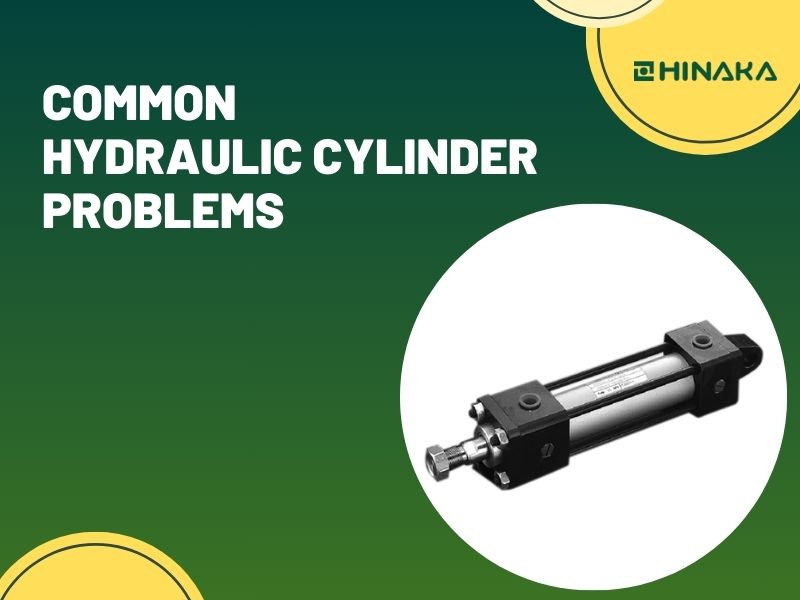Knowledge
Common Hydraulic Cylinder Problems and How to Prevent Them
2025/ 03/ 20

Hydraulic cylinders are essential components in industrial machinery, providing the force needed for heavy lifting, precise movement, and high-pressure applications. However, like any mechanical system, hydraulic cylinders are susceptible to wear and tear, leading to performance issues and potential downtime.
At HINAKA, we specialize in high-quality hydraulic cylinders designed for durability, reliability, and precision. Our expertise in pneumatic and hydraulic components ensures that our products meet the demands of various industries, from manufacturing and automation to heavy-duty industrial applications.
In this article, we will explore some of the most common hydraulic cylinder problems and provide practical prevention tips to help maintain the longevity and efficiency of your equipment.
1. Hydraulic Fluid Leaks
Problem:
Hydraulic leaks are one of the most frequent issues in hydraulic cylinders. Leaks can occur due to worn-out seals, damaged hoses, cracks in the cylinder body, or improper fittings. Even minor leaks can cause pressure loss, reducing efficiency and increasing energy consumption.
How to Prevent It:
- Regularly inspect seals and fittings for wear or damage.
- Use high-quality hydraulic fluid to prevent premature seal deterioration.
- Ensure proper installation of seals and fittings to prevent misalignment.
- Avoid excessive system pressure, which can cause seals to rupture.
2. Contaminated Hydraulic Fluid
Problem:
Contaminated hydraulic fluid can result in abrasive wear, corrosion, and sluggish cylinder movement. Dirt, debris, and moisture entering the hydraulic system can clog valves and damage internal components.
How to Prevent It:
- Use high-quality hydraulic oil that meets industry standards.
- Regularly replace hydraulic fluid according to the manufacturer’s recommendations.
- Install and maintain proper filtration systems to remove impurities.
- Keep hydraulic reservoirs sealed to prevent external contamination.
3. Cylinder Drift (Pressure Loss)
Problem:
Cylinder drift occurs when the hydraulic cylinder gradually loses pressure, causing unintended movement. This can be caused by internal leaks, worn seals, faulty valves, or a failing piston. Cylinder drift reduces efficiency and poses safety risks in industrial applications.
How to Prevent It:
- Regularly inspect piston seals and replace them when signs of wear appear.
- Check for internal leaks by conducting a pressure test on the cylinder.
- Ensure proper valve function by testing directional control and check valves.
- Use compatible hydraulic fluid to maintain optimal lubrication and sealing properties.
4. Bent or Damaged Piston Rod
Problem:
A bent piston rod can occur due to excessive side loads, improper alignment, or impacts during operation. A misaligned or overloaded cylinder can cause the rod to bend, leading to uneven wear, leaks, and potential system failure.
How to Prevent It:
- Ensure proper alignment of the cylinder and load to prevent side loading.
- Use a cylinder with a thicker or stronger rod for heavy-duty applications.
- Install external support guides to minimize bending forces.
- Avoid exceeding the cylinder's rated load capacity.
5. Corrosion and Rust
Problem:
Hydraulic cylinders often operate in harsh environments where exposure to moisture, chemicals, and extreme temperatures can cause corrosion and rust. Corroded cylinders lose strength and may develop leaks, pitting, and weakened structural integrity.
How to Prevent It:
- Use corrosion-resistant materials, such as stainless steel or coated cylinder rods.
- Apply protective coatings to prevent rust formation.
- Store equipment in a dry environment when not in use.
- Regularly clean cylinders to remove dirt, moisture, and chemicals.
6. Overheating of Hydraulic Cylinders
Problem:
Excessive heat buildup in hydraulic systems can cause fluid degradation, seal failure, and reduced efficiency. Overheating is often due to excessive pressure, high duty cycles, or insufficient cooling mechanisms.
How to Prevent It:
- Monitor system temperature and ensure it stays within the recommended operating range.
- Use heat exchangers or cooling fans in high-temperature environments.
- Avoid prolonged high-pressure operation without adequate cooling.
- Ensure proper fluid levels and use heat-resistant hydraulic fluids when necessary.
7. Slow or Erratic Cylinder Movement
Problem:
If a hydraulic cylinder moves too slowly, erratically, or with jerky motions, it may be due to air pockets, low fluid levels, or internal blockages. This can cause inconsistent performance and reduce productivity.
How to Prevent It:
- Bleed air from the system to remove trapped air pockets.
- Maintain proper fluid levels to prevent cavitation.
- Inspect and clean hydraulic filters to ensure unobstructed fluid flow.
- Lubricate moving parts regularly to reduce friction and wear.
Conclusion
Hydraulic cylinders are critical to many industrial processes, but without proper maintenance, they can develop leaks, drift, contamination, overheating, and mechanical damage. By implementing preventive maintenance strategies, businesses can extend the lifespan of their hydraulic cylinders, reduce downtime, and improve overall efficiency.
At HINAKA, we specialize in high-quality hydraulic cylinders designed for durability, reliability, and precision. Whether you need standard cylinders or custom solutions, our products are engineered to withstand demanding industrial conditions. Contact us today to learn how our hydraulic cylinders can optimize your operations and minimize maintenance challenges.
Recent Article
- Pneumatic Boosting Cylinder vs. Hydraulic Cylinder: Which One is Better for Your Industry?
- Air Hydraulic Unclamping Cylinders: Enhancing Efficiency and Precision
- Pneumatic Cylinders: The Essential Guide for Industrial Applications
- 7 Key Benefits of Hydraulic Cylinders in Industrial Applications
- 5 Reasons to Choose a Boosting Cylinder for Your Industrial Needs